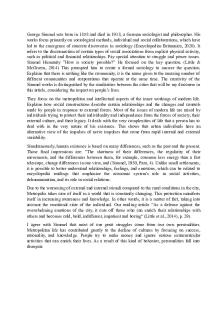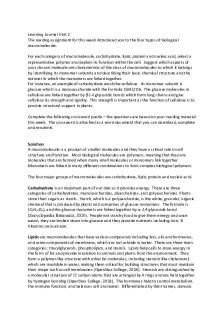UNIT 3 Learning Journal PDF

| Title | UNIT 3 Learning Journal |
|---|---|
| Author | erik silverman |
| Course | Introduction to Statistics |
| Institution | University of the People |
| Pages | 2 |
| File Size | 90.4 KB |
| File Type | |
| Total Downloads | 72 |
| Total Views | 161 |
Summary
Download UNIT 3 Learning Journal PDF
Description
Learning Journal Unit 3 1. Learning Journal Reflective Comments: - Nov 27, 2020: Read chapter 3 of the textbook. This week’s chapter covers how to produce histograms and box plots; calculate mean, median, ariance, standard deviation, and inter-quartile range. While reading the chapter, I computed the numerical measures using R. The outputs were the same as presented in the textbook. - Nov 28, 2020: Watched the videos in reading assignment. That helped me get more understanding of what I read from the textbook.. - Nov 29, 2020: Did the self-quiz and Supplementary Exercise. The quiz is very helpful for me since I can practice how to associate each box plot with its relative histogram and get ready for the Graded Quiz. - Nov 30, 2020: Completed the Graded Quiz for Unit 3. - Dec 1, 2020: Posted my answer to the Discussion Forum. Did the Peer Assessment for 3 students in Unit 2. - Dec 2, 2020: Rated and replied to other posts in the Discussion Forum.Finished up the learning journal. 2. Vocabulary and R functions a. What does the length function tell you? For vectors (including lists) and factors the length is the number of elements. For example: > x length(x) [1] 16 The length function shows us that there are 16 elements in the data set x. b. Description of variance: For a set of data, if x is a value of one observation and ¯x is the mean value of all observations, then (x - ¯x) is the deviation. Now if we sum the square of the deviations and divide by the total number of data values minus one (n − 1), we will get the variance, i.e:
3.
According to Yakir (2011), dividing by n or by n − 1 only makes a difference if the size of the data is big. Once we get the variance, we can easily calculate the standard deviation which represents how far data values are from their mean. Standard deviation is the most important measure of the spread and is obtained by taking the square root of the variance: s = √ ❑ For the past couple of weeks, I would say I spent around 8 hours on this class. As the upcoming weeks require more study, I will spend extra hours over the weekends. My schedule of studying Statistics will look like this:
Days of the week
Thursd ay
Friday
Saturda y
Sunday
Monday Tuesda y
Wedne sday
Number s of hours spent on Statistic s
1.5
1.5
2.5
2.5
1.5
1.5
1.5
Reference: Yakir, B. (2011). Introduction to Statistical Thinking (With R, Without Calculus). Retrieved December 02, 2020, from https://my.uopeople.edu/pluginfile.php/1020851/mod_resource/content/4/IntroSta t.pdf...
Similar Free PDFs

Learning Journal Unit 3
- 2 Pages

Learning journal unit 3
- 2 Pages

UNIT 3 Learning Journal
- 2 Pages

LJ3 learning journal unit 3
- 2 Pages

Learning journal unit 4
- 3 Pages

Learning Journal Unit 1
- 2 Pages

Learning Journal Unit 8
- 2 Pages

Learning Journal unit 7
- 2 Pages

Learning Journal Unit 8
- 2 Pages

Learning Journal Unit 6
- 1 Pages

Learning Journal Unit 2
- 2 Pages

Learning Journal. Unit 6
- 3 Pages

Learning Journal Unit 2
- 2 Pages

Learning Journal Unit 4
- 2 Pages
Popular Institutions
- Tinajero National High School - Annex
- Politeknik Caltex Riau
- Yokohama City University
- SGT University
- University of Al-Qadisiyah
- Divine Word College of Vigan
- Techniek College Rotterdam
- Universidade de Santiago
- Universiti Teknologi MARA Cawangan Johor Kampus Pasir Gudang
- Poltekkes Kemenkes Yogyakarta
- Baguio City National High School
- Colegio san marcos
- preparatoria uno
- Centro de Bachillerato Tecnológico Industrial y de Servicios No. 107
- Dalian Maritime University
- Quang Trung Secondary School
- Colegio Tecnológico en Informática
- Corporación Regional de Educación Superior
- Grupo CEDVA
- Dar Al Uloom University
- Centro de Estudios Preuniversitarios de la Universidad Nacional de Ingeniería
- 上智大学
- Aakash International School, Nuna Majara
- San Felipe Neri Catholic School
- Kang Chiao International School - New Taipei City
- Misamis Occidental National High School
- Institución Educativa Escuela Normal Juan Ladrilleros
- Kolehiyo ng Pantukan
- Batanes State College
- Instituto Continental
- Sekolah Menengah Kejuruan Kesehatan Kaltara (Tarakan)
- Colegio de La Inmaculada Concepcion - Cebu

